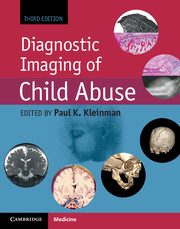Book contents
- Frontmatter
- Dedication
- Contents
- List of Contributors
- Editor’s note on the Foreword to the third edition
- Foreword to the third edition
- Foreword to the second edition
- Foreword to the first edition
- Preface
- Acknowledgments
- List of acronyms
- Introduction
- Section I Skeletal trauma
- Section II Abusive head and spinal trauma
- Section III Visceral trauma and miscellaneous abuse and neglect
- Section IV Diagnostic imaging of abuse in societal context
- Section V Technical considerations and dosimetry
- Index
- References
Introduction
Published online by Cambridge University Press: 05 September 2015
- Frontmatter
- Dedication
- Contents
- List of Contributors
- Editor’s note on the Foreword to the third edition
- Foreword to the third edition
- Foreword to the second edition
- Foreword to the first edition
- Preface
- Acknowledgments
- List of acronyms
- Introduction
- Section I Skeletal trauma
- Section II Abusive head and spinal trauma
- Section III Visceral trauma and miscellaneous abuse and neglect
- Section IV Diagnostic imaging of abuse in societal context
- Section V Technical considerations and dosimetry
- Index
- References
Summary
Definition of child abuse
There is a wide range of views among professionals as to what is an acceptable definition of child abuse. The lack of universally accepted terminology to characterize the fundamental elements of this condition illustrates the difficulty in developing a precise definition. The battered child syndrome seemed to be an apt characterization of the injuries described in early reports; however, the term implies that an infant or child is hit with a fist, foot, or blunt object (1). Some injuries are inflicted in this manner, but most occur by indirect forces that develop as the child is grabbed by the trunk or an extremity, is shaken, slammed, or thrown.
Although assailants may be unaware of the ultimate consequences of their actions, the abusive event generally implies a willful assault on a child at the hands of a person entrusted with their care. The term “nonaccidental injury” characterizes the condition by what it is not, rather than by what it is. It requires a reliable definition of what constitutes an accident and implies that if an injury is not due to an accident, it is due to abuse. Some authors link abuse to intentionality (2–4). Intent is often included in legal standards; the notion is a complex one and is not easily applied to the clinical setting by most physicians dealing with traumatic injuries. On occasion, euphemisms and confusing terms such as “trauma-X” are employed to hide the diagnosis from the victim’s family or other caretakers, and such terminology may actually hinder initial contacts with these parties as well as undermine the trust that must be established for optimal intervention and treatment.
- Type
- Chapter
- Information
- Diagnostic Imaging of Child Abuse , pp. 1 - 6Publisher: Cambridge University PressPrint publication year: 2015



